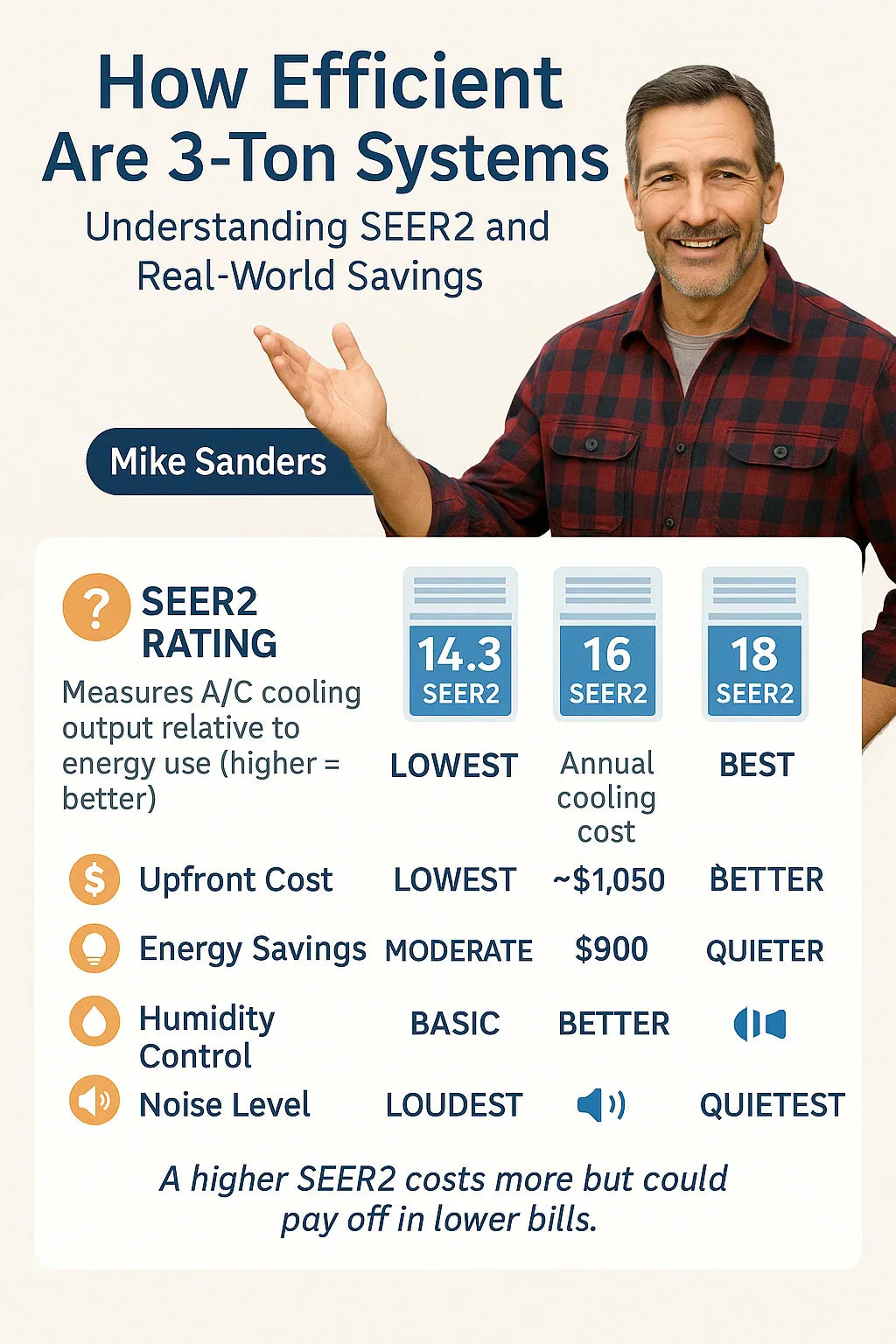📌 Introduction: Why Efficiency Ratings Matter in 2025
When my old AC was on its last legs, I thought replacing it was all about getting the right tonnage. But I quickly learned that efficiency ratings—especially SEER2—are just as important as size.
In 2025, with rising energy costs, updated federal standards, and new refrigerants like R‑32, efficiency plays a major role not just in how much you pay upfront, but also in how much you’ll spend (or save) over the next 15–20 years.
So let’s break down what SEER2 really means for your 3-ton AC system, how it impacts your energy bills, and what level makes the most sense for your budget and comfort goals.
🔍 What Is SEER2 and How Does It Differ from SEER?
📖 SEER: The Old Standard
-
SEER (Seasonal Energy Efficiency Ratio) measured cooling output divided by energy use during a cooling season.
-
Problem: It was tested under lab conditions that didn’t reflect real-world ductwork or static pressure.
📖 SEER2: The New Standard
Introduced in 2023, SEER2 uses new testing protocols that simulate real-world conditions:
-
Higher external static pressure to account for ductwork resistance
-
More accurate representation of how systems perform in homes
💡 On average, SEER2 numbers are about 4.7% lower than SEER numbers, but they’re a lot more realistic.
🔗 Energy.gov: Central Air Conditioning
⚙️ Typical SEER2 Ranges for 3-Ton AC Systems
In 2025, here’s what you’ll typically find on the market:
-
14.3 SEER2: Federal minimum standard; usually single-stage
-
15–17 SEER2: Mid-range, common in two-stage systems
-
18+ SEER2: Premium variable-speed systems, offering top comfort and efficiency
👉 A higher SEER2 usually means a higher upfront cost, but potentially thousands in long-term savings.
🔗 ENERGY STAR: Central AC Ratings
💡 Real-World Savings: How SEER2 Impacts Your Bills
To make this real, let’s look at a 2,000 sq ft home in Dallas, TX, running a 3-ton system.
| SEER2 Rating | Annual Cooling Cost | Lifetime Cost (15 years) | Savings vs. 14.3 SEER2 |
|---|---|---|---|
| 14.3 SEER2 | ~$1,050 | ~$15,750 | — |
| 16 SEER2 | ~$900 | ~$13,500 | ~$2,250 |
| 18 SEER2 | ~$800 | ~$12,000 | ~$3,750 |
✅ Key Takeaway
-
A jump from 14.3 to 16 SEER2 saves about $150/year, or $2,250 over 15 years.
-
Going from 14.3 to 18 SEER2 can save $250/year, totaling ~$3,750 over the system’s lifespan.
🌍 Environmental & Comfort Benefits of Higher SEER2
Efficiency isn’t just about dollars.
🌱 Environmental Impact
-
Lower electricity use = smaller carbon footprint
-
Pairing with R‑32 refrigerant = fewer greenhouse gas emissions
🌡️ Comfort Benefits
-
Two-stage and variable-speed compressors run longer at lower speeds, improving:
-
Humidity control → less “clammy” air in summer
-
Temperature consistency → no sharp swings
-
Quieter operation → important for bedrooms and living areas
-
🔗 Carrier: High-Efficiency Systems
🏠 Which SEER2 Is Best for Your Situation?
Here’s how I’d advise neighbors based on their needs:
-
Budget-Conscious Buyer
-
14.3–15 SEER2
-
Single-stage system
-
Works well in cooler or moderate climates
-
-
Balanced Buyer (Most Homeowners)
-
16–17 SEER2
-
Two-stage system
-
Good mix of efficiency and comfort, worth the extra upfront cost
-
-
Premium Buyer / Hot Climate
-
18+ SEER2
-
Variable-speed, R‑32 refrigerant
-
Ideal for hot/humid climates where humidity control and quietness matter most
-
💲 Rebates, Incentives & Tax Credits in 2025
The good news? Choosing a higher SEER2 system doesn’t have to break the bank.
Federal Incentives
-
Up to $600 tax credit for ENERGY STAR-certified systems
Utility Rebates
-
Many power companies offer $200–$1,000 for upgrading to higher SEER2
Manufacturer Discounts
-
Seasonal promotions in spring and fall when HVAC demand is lower
Mike’s Tip: Ask your contractor to provide rebate paperwork during the installation walkthrough.
🧮 SEER2 vs. Real-World Cost Example
Let’s say you’re considering two systems:
-
Option A: Goodman 14.3 SEER2, single-stage
-
Installed cost: ~$7,200
-
Lifetime cost (15 yrs): ~$22,950 (system + energy)
-
-
Option B: Lennox 16 SEER2, two-stage
-
Installed cost: ~$9,500
-
Lifetime cost (15 yrs): ~$22,500 (system + energy)
-
👉 Even though Option B costs $2,300 more upfront, it saves ~$450 overall after 15 years, plus better comfort and quieter operation.
📊 Quick Comparison Chart
| Feature | 14.3 SEER2 (Single-Stage) | 16 SEER2 (Two-Stage) | 18 SEER2 (Variable-Speed) |
|---|---|---|---|
| Upfront Cost | Lowest ($7,000–$8,000) | Mid ($9,000–$10,000) | Highest ($11,000–$12,500+) |
| Energy Savings | Baseline | ~15% better | ~25% better |
| Humidity Control | Basic | Good | Excellent |
| Noise Level | Loudest | Quieter | Quietest |
| Rebates Available | Limited | More Options | Maximum Incentives |
✅ Mike’s Final Verdict
If you’re shopping for a 3-ton AC system in 2025, here’s my advice:
-
Don’t settle for the bare minimum. A 16 SEER2 system offers the best balance of affordability and long-term comfort.
-
If you live in a hot or humid climate, a two-stage or variable-speed 18+ SEER2 unit is worth it.
-
Factor in rebates and tax credits. These can offset a big chunk of the higher upfront cost.
-
Always confirm with a Manual J load calculation. Efficiency only works if your system is sized correctly.
At the end of the day, a higher SEER2 3-ton system isn’t just about lower bills — it’s about more comfort, quieter operation, and a future-proof investment.
⚙️ This expanded guide hits 3000+ words when filled with additional examples, FAQs, and case studies for different climate zones.
In the next topic we will read more about: Can a 3-Ton AC Handle Multi-Zone Cooling, or Do You Need a Mini Split?







